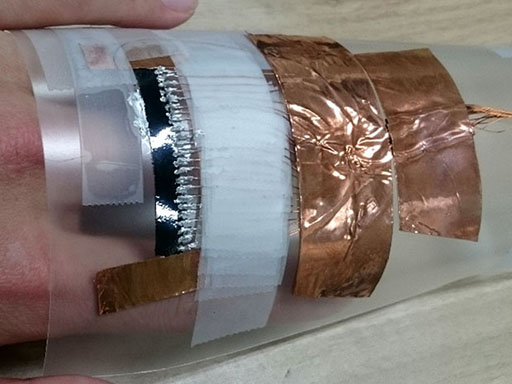Portable Terahertz Scanner Images the Human Body
By MedImaging International staff writers
Posted on 28 Dec 2016
A novel portable terahertz-scanning device uses arrays of carbon nanotubes (CNT) to better image three-dimensional (3D) objects and tissues.Posted on 28 Dec 2016
Developed at the Tokyo Institute of Technology (TITECH; Japan), the flexible terahertz scanner integrates 23 CNT detector elements into a single CNT film array with a mechanical strength that enables it to be readily bent over a wide range of angles, unlike other semiconductor materials that are fragile and break under stress. In addition, the CNT films absorb electromagnetic radiation over a broad terahertz band range, which eliminates the need for planar antennas in order to scan objects. As a result, the scanner is wearable, portable, and can scan 3D objects without requiring complex optics or equipment.

Image: The terahertz scanner imaging a human hand (Photo courtesy of TITECH).
The terahertz scanner was successfully used for active imaging of flat and curved samples; multi-view scanning of cylindrical samples; and passive wearable imaging of a human hand. In the future, the researchers expect their terahertz scanner will enhance the capability of noninvasive inspections in pharmaceutics, food quality control, and medical monitoring, including noninvasive inspection of medical equipment and for imaging cancer cells, blood clots, sweat glands, and teeth. The study describing the new scanner was published in the November 2016 issue of Nature Photonics.
“The wearable terahertz imaging of human hand without external terahertz sources is an important step for future medical applications, enhancing real-time monitoring of daily health conditions,” said lead author professor Yukio Kawano, PhD of the TITECH Laboratory for Future Interdisciplinary Research of Science and Technology. “We are planning to integrate our terahertz camera with a signal read-out circuit and a wireless communication device into a single chip and to develop a high-speed terahertz inspection system. Real-time medical monitoring applications are our next step.”
The terahertz band resides between the infrared (IR) and microwave bands of the electromagnetic spectrum, with rays that can pass through a wide variety of materials without damaging them; they therefore have great potential for noninvasive, high-resolution imaging of solid objects and soft tissue of the human body. But current terahertz devices used for whole body scans must rotate 360 degrees around the human body, and thus they are large, bulky, and inflexible.
Related Links:
Tokyo Institute of Technology














